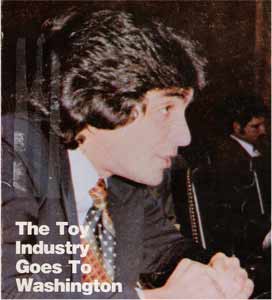
WASHINGTON, D.C. May 1979 -Martin Abrams, president of Mego Corp., threw away his prepared testimony at the Federal Trade Commission hearings here and - speaking extemporaneously - made his case against any further restrictions or possible ban on TV advertising to children. "You want us to do what we're practically doing now," he said. "Commercials with no puffery and very little action. You want us to come up here and say: 'This is a toy, it walks and crawls, it bends and moves. If you like it buy it - if you don't, don't buy it.' Today, close to 60% of our TV advertising does that because of other (existing) regulations. " Abrams added that Mego's commercials today are "boring" due to restrictions from the National Association of Broadcasters (NAB) and federal regulatory agencies. "Weare very limited in the amount of things we can do with our product," he said. "We have, literally, spokesmen's commercials with no settings. We show the product and we show what it does."
He explained that toy manufacturers rely on TV to help sell directly to the consumer - creating a need in the market to leverage sometimes-reluctant retail buyers into carrying the products. "We have to be able to sell Sears Roebuck, J.C. Penney, the K mart Corporation, Toys 'R' Us and distributors around the country to get market penetration," he said. "We have to appeal to a wide range of consumers in the marketplace. "Once ABC goes down from 9.5 minutes to 6.5 minutes (per hour commercials on children's programming) you have to go to spot markets because there's less time and time has to be picked up in order for the consumer to see the. product," he said.
. In short, he explained, smaller"toy manufacturers need TV to take their products directly to the con sumer - as a tool to then compete with larger manufacturers who already have the shelf space at retail." ".We haven't got the financial wherewithall to go against a MatteI or a General Mills," he said. "To firms like ours, if you take away the media, that's our great equalizer." Further, Abrams stressed his evaluation that children can judge toys promoted on TV. Consumer groups, such as Action for Children's Television, contend that not only can't children evaluate product - they really aren't clear on the difference between a commercial and regular programming.
Further, Abrams stressed his evaluation that children can judge toys promoted on TV. Consumer groups, such as Action for Children's Television, contend that not only can't children evaluate product - they really aren't clear on the difference between a commercial and regular programming. "Kids are sophisticated, they are aware. They make their decisions. They know what they like and they know what they don't like," he said. Abrams conceded that, in the past, some toy manufacturers did use invalid means to advertise product on TV to children: "In 1971-72 there was a lot of abuse in advertising," he said. "I can quite clearly say that we (Mego) were not part of that abuse, which included over-dramatization, still photography, etc.
"I've had too many failures in this business to ever believe that a . . . child has no critical perception of a product." - Abrams
"I've had too many failures in this business to ever believe that a three, seven or eight-year-old child has no critical perception of a product," he said. He used the example of the TV doll market - in which some $19 million is spent annually on some 25 major offerings - the child picks only a handful."Who is making that decision? That parent isn't making that decision - the child is," he said. "Of approximately 25 different dolls, they're picking maybe one, 2 or 3." . He noted that as specialty toy retailers continue to grow - such as Toys 'R' Us - parents and children are confronted with warehouses of toys of 30,000 sq. ft. with inventory levels of $750,000. TV ads help consumers make buying decisions, he said.